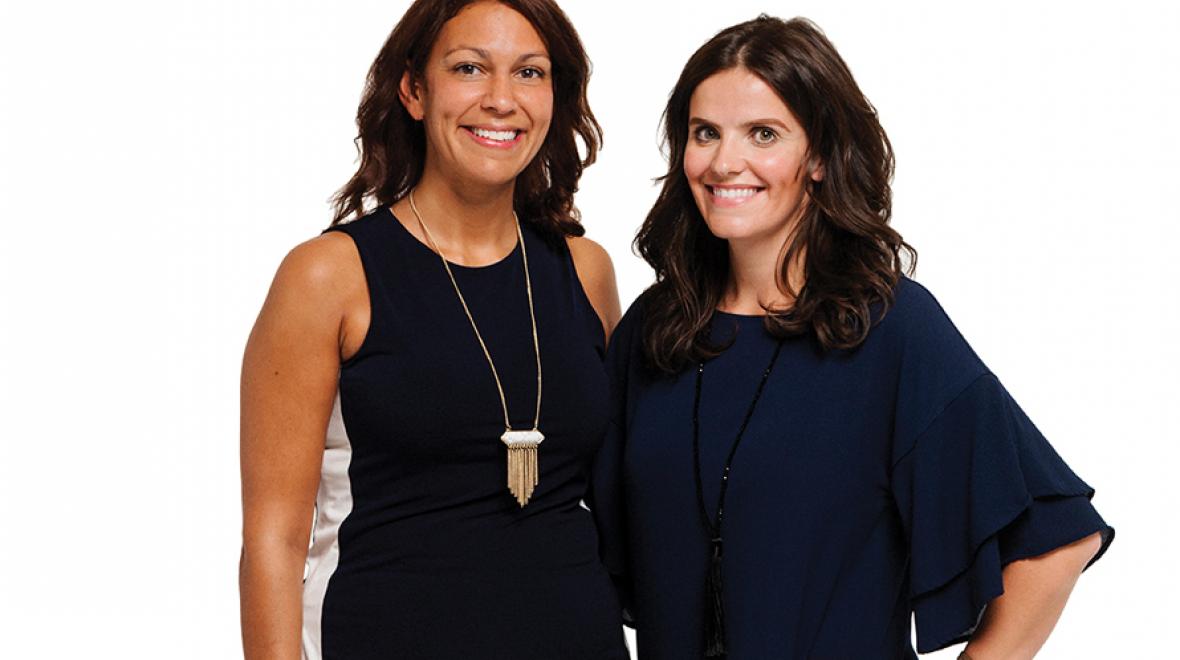
Photo:
Tara and Dani | Credit: Will Austin
In the Pacific Northwest, we like to think we are on the bleeding edge of progressive innovation in all areas of life, but an assessment of how men and women are differently compensated in our industries, organizations and economy reveals a sobering truth: The gender wage gap in Washington state is one of the largest in the country. The stats are startling: A recent analysis indicates that women who work full-time year around earn just 79 cents for every $1 earned by men, and moms who work full-time and have school-age children earn 58 percent of what comparable working fathers earn. In particular, King County boasts a higher percentage of women in the workforce than Washington state or the nation, yet it has a wider gender wage gap than either the state or the country as a whole. If King County were a state, its wage gap would be worse than 41 other states.
Dani Carbary and Tara Buchan are committed to challenging and changing this reality, one conversation and one strategic partnership at a time. This dynamic duo works (as the director and the program manager, respectively) for 100% Talent, an initiative of the Women’s Funding Alliance aimed at raising awareness of equity issues and creating a collaborative coalition of member employers (called signatories) to redress the systemic factors that contribute to the impacts of the gender gap on women in our region’s workforce. The initiative’s ultimate goal? To ensure that everyone is paid for 100 percent of the valuable work they do.
We caught up with Carbary and Buchan to learn more about 100% Talent.
What’s the founding story of 100% Talent?
Carbary: In 2013, the National Partnership for Women and Families released a report that found Seattle had the worst wage gap among the country’s 50 largest metropolitan areas. Local leaders immediately began working on assembling a city taskforce and convening business leaders in a similar effort. They put their heads together to create a voluntary, employer-led program to emphasize best practices and collective learning and action: the 100% Talent initiative. Led by the Women’s Funding Alliance, a nonprofit advancing the economic and leadership opportunities for girls and women in Washington state, initial support for the endeavor came from founding signatories Amazon, Alaska Airlines, T-Mobile, Microsoft, Ben Bridge, King County, the City of Seattle and the Seattle Metropolitan Chamber of Commerce. These large local employers were the first to make the pledge toward workplace equity, and their financial support helped us establish our programming.
Buchan: We’ve grown to nearly 90 organizations strong today!
What are the key stats and contributing factors to our state’s gender wage gap?
Buchan: Both occupational segregation and the opportunity gap are key contributors to our local wage gap. As a woman moves up in her career, her wage gap widens while her opportunities for advancement diminish.
Carbary: Earlier this year, PayScale released a “State of the Gender Pay Gap” report showing that women tend to be overrepresented in lower-paying industries, and men are over-represented in higher-paying industries, such as engineering and computer science. One of the more maddening statistics, however, shows that plain old bias still plays a huge part in this issue. Data shows that as women move into and take over male-dominated fields, the pay actually drops!
I read on the 100% Talent website that if we continue with business as usual, women in our region won’t earn the same as men until the year 2070. What are the key strategies and initiatives that 100% Talent is employing to close that gap?
Buchan: We believe that our employer-led approach can make a real difference in influencing change. Our 100% Talent signatories [which collectively employ 1.5 million people globally] are working together to tackle the systemic factors that contribute to the wage gap: things like unconscious bias in organizational culture, hiring, salary negotiations and performance evaluation practices. Then there’s the need to provide flexible work arrangements and prioritize equal female representation in senior leadership.
Carbary: Fundamentally, our signatory organizations show commitment to creating better pipelines for women into middle- and high-wage industries. When women participate in the workplace equally, 100 percent of our local talent is empowered to innovate and grow business. Also, when you consider that women in the United States typically control 73 percent of household spending, you can imagine the positive effect of closing the gap — billions of dollars put to work in the economy.
What is 100% Talent’s process for identifying employers/signatories, and what do those engagements typically look like?
Buchan: We’ve been really lucky to have the active participation of some of the most well-known companies in the world. The employees at these companies who dedicate their support for our mission are key to advancing our work and driving awareness. They connect us with other like-minded business contacts, who are usually enthusiastic about getting involved. On the flip side, we’re also constantly reaching out to new contacts, attending events …
Carbary: … and just pounding the pavement old-school style to get our message of workplace equity out into the world.
What are the best practices that are proving most successful in changing the culture and achieving gender equity in the organizations you work with?
Carbary: Each company is different. Some companies might benefit from taking a look at their hiring structure and creating practices that are free of bias. Other companies may have identified that women seem to be promoted less often than their male counterparts, so creating mentorship and sponsorship programs along with structural support to move women up the talent pipeline will be a game changer for their company and the women they employ.
Buchan: Some of our signatories have really figured out best practices around workplace flexibility, but maybe need help with compensation evaluation, tools and metrics. We love working with these organizations to identify where they can improve. Sometimes that improvement is accelerated when we can connect them with other companies that have walked that same walk, but may be further down the path.
Are there particular areas of emphasis in 100% Talent’s research and program development?
Carbary: Yes! It is so important to recognize and take specific action around the gaps between women. At every level and on each issue regarding the wage gap, women of color encounter additional barriers. A great example is Equal Pay Day, a day symbolizing how far into the year women must work in order to earn what men earned in the previous year. We recognized Equal Pay Day for all women on April 2 this year, but we won’t see Equal Pay Day for Black women until August 22. Latina women’s equal pay day isn’t until November 20!
Buchan: We also focus on combating the “caretaker penalty”: things such as offering paid family leave, encouraging those with power in an organization to “parent loudly,” giving new parents support both during leave and at work. Other examples could be outside-the-box benefits like flextime, meal stipends for new parents, nursing and pumping support and clothing rental for mothers who are returning to work and want to dress professionally, but don’t want to buy a whole new wardrobe in a size they won’t be in a few months.
What is a perhaps surprising tactic for diminishing the gap that people might not consider?
Carbary: Data shows that equalizing parental leave can be a key contributor to shrinking the gap, so we also work with companies to reevaluate their leave policies and to train managers to support and encourage taking advantage of these policies. We know that even if a company has the most generous leave policy, it doesn’t matter if their employees don’t use the benefit — specifically fathers.
Buchan: Right. We learned from our signatories that simply changing the question “Will you be taking leave when your new child arrives?” to “How will you be taking your leave when your new child arrives?” can skyrocket paid-leave utilization among fathers. This also leads to lower turnover among female employees, as well.
What can an employer reading this do to take action?
Carbary: Visit our website to learn more about our work and consider if they’d like to join the initiative. Our goal, first and foremost, is to generate awareness that leads to change, so we are happy to meet with anyone interested in learning more about the 100% Talent mission.
What motivates you as individuals to do this work?
Buchan: I am inspired every time we get someone to look at all of the data around contributing factors and realize that a systemic change is needed. And how cool it is that their company can be part of the solution! We get to motivate the people involved in creating change within their organizations, and we are definitely motivated in return. When we get together as a group of signatories, every single person is there because they want to be. They’re committed to developing the best possible workplace culture and making their organizations a place where all employees feel included. That is very rewarding work, and it continues to push us to go far and wide with our mission.
Carbary: The late Paul Allen once said, “As long as we work together, with both urgency and determination, there are no limits to what we can achieve.” This is very much how I feel about our partnership, and the partnership that 100% Talent has with its signatories.











